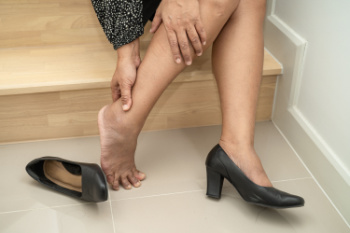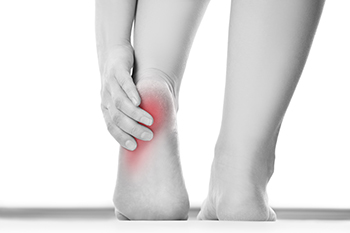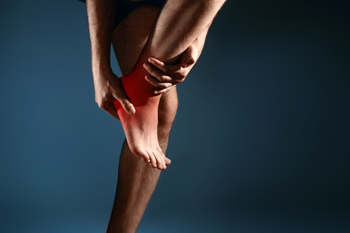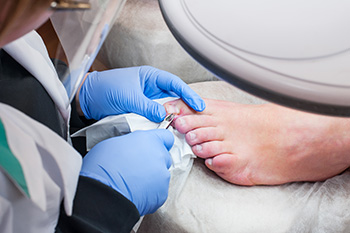Items filtered by date: April 2025
Imaging the Source of Chronic Foot Pain

When foot pain becomes chronic and does not improve with rest or basic care, radiologic evaluation can help uncover the cause. X-rays are often the first step, useful for detecting fractures, arthritis, or structural changes. If soft tissue issues are suspected, such as tendon injuries, nerve problems, or inflammation, an MRI or ultrasound scan may be recommended. CT scans offer detailed images of complex bone structures and are sometimes used for surgical planning. These imaging tools allow podiatrists to see beyond the surface, helping to identify hidden conditions that might not be obvious through physical examination alone. Accurate imaging leads to more effective treatment by targeting the exact source of pain. If you have ongoing foot pain that remains unexplained, it is suggested you see a podiatrist for a diagnosis and appropriate treatment.
Foot Pain
Foot pain can be extremely painful and debilitating. If you have a foot pain, consult with Lance Greiff, DPM from Great Neck Podiatry. Our doctor will assess your condition and provide you with quality foot and ankle treatment.
Causes
Foot pain is a very broad condition that could be caused by one or more ailments. The most common include:
- Bunions
- Hammertoes
- Plantar Fasciitis
- Bone Spurs
- Corns
- Tarsal Tunnel Syndrome
- Ingrown Toenails
- Arthritis (such as Gout, Rheumatoid, and Osteoarthritis)
- Flat Feet
- Injury (from stress fractures, broken toe, foot, ankle, Achilles tendon ruptures, and sprains)
- And more
Diagnosis
To figure out the cause of foot pain, podiatrists utilize several different methods. This can range from simple visual inspections and sensation tests to X-rays and MRI scans. Prior medical history, family medical history, and any recent physical traumatic events will all be taken into consideration for a proper diagnosis.
Treatment
Treatment depends upon the cause of the foot pain. Whether it is resting, staying off the foot, or having surgery; podiatrists have a number of treatment options available for foot pain.
If you have any questions, please feel free to contact our offices located in Great Neck Bronx, NY . We offer the newest diagnostic and treatment technologies for all your foot care needs.
Gout in the Heel

Gout in the heel is a painful condition that occurs when uric acid builds up in the bloodstream, forming crystals that deposit in the joints, including the heel. This typically happens when the body is unable to eliminate excess uric acid, often due to factors like consuming purine-rich foods like red meat or shellfish. Alcohol or dehydration can also play a role. While gout is commonly felt in the big toe, it also can affect the heel. Symptoms of gout in the heel include intense, sudden pain, swelling, and redness, often worsening at night. The pain can be sharp and throbbing, making even the slightest pressure, such as walking or wearing shoes, extremely uncomfortable. The heel may also feel warm to the touch, and the skin around the area may appear inflamed. A podiatrist can diagnose gout through physical exams, blood tests, and joint fluid analysis. They can offer treatments such as medications to reduce inflammation and pain, lifestyle advice to lower uric acid levels, and guidance on proper footwear. If you are dealing with this condition, it is suggested that you make an appointment with a podiatrist for care.
Gout is a painful condition that can be treated. If you are seeking treatment, contact Lance Greiff, DPM from Great Neck Podiatry. Our doctor will treat your foot and ankle needs.
What Is Gout?
Gout is a form of arthritis that is characterized by sudden, severe attacks of pain, redness, and tenderness in the joints. The condition usually affects the joint at the base of the big toe. A gout attack can occur at any random time, such as the middle of the night while you are asleep.
Symptoms
- Intense Joint Pain - Usually around the large joint of your big toe, and it most severe within the first four to twelve hours
- Lingering Discomfort - Joint discomfort may last from a few days to a few weeks
- Inflammation and Redness -Affected joints may become swollen, tender, warm and red
- Limited Range of Motion - May experience a decrease in joint mobility
Risk Factors
- Genetics - If family members have gout, you’re more likely to have it
- Medications - Diuretic medications can raise uric acid levels
- Gender/Age - Gout is more common in men until the age of 60. It is believed that estrogen protects women until that point
- Diet - Eating red meat and shellfish increases your risk
- Alcohol - Having more than two alcoholic drinks per day increases your risk
- Obesity - Obese people are at a higher risk for gout
Prior to visiting your podiatrist to receive treatment for gout, there are a few things you should do beforehand. If you have gout you should write down your symptoms--including when they started and how often you experience them, important medical information you may have, and any questions you may have. Writing down these three things will help your podiatrist in assessing your specific situation so that he or she may provide the best route of treatment for you.
If you have any questions, please feel free to contact our offices located in Great Neck Bronx, NY . We offer the newest diagnostic and treatment technologies for all your foot care needs.
Symptoms and Causes of Poor Circulation in the Feet

Poor circulation in the feet can lead to discomfort and may signal underlying health concerns. Common symptoms include cold feet, tingling, numbness, cramping, or a heavy sensation, especially during walking or rest. The skin may appear pale or bluish, and wounds may heal slowly. These signs often result from reduced blood flow, which limits oxygen and nutrient delivery to the tissues. Causes include peripheral artery disease, where narrowed blood vessels restrict circulation, and diabetes, which can damage blood vessels over time. Other contributing factors are smoking, obesity, and a sedentary lifestyle. Poor circulation can also stem from blood clots or nerve conditions. If you have any of the above symptoms, it is strongly suggested that you visit a podiatrist who can help you to manage this condition.
Poor circulation is a serious condition and needs immediate medical attention. If you have any concerns with poor circulation in your feet contact Lance Greiff, DPM of Great Neck Podiatry. Our doctor will treat your foot and ankle needs.
Poor Circulation in the Feet
Poor blood circulation in the feet and legs is can be caused by peripheral artery disease (PAD), which is the result of a buildup of plaque in the arteries.
Plaque buildup or atherosclerosis results from excess calcium and cholesterol in the bloodstream. This can restrict the amount of blood which can flow through the arteries. Poor blood circulation in the feet and legs are sometimes caused by inflammation in the blood vessels, known as vasculitis.
Causes
Lack of oxygen and oxygen from poor blood circulation restricts muscle growth and development. It can also cause:
- Muscle pain, stiffness, or weakness
- Numbness or cramping in the legs
- Skin discoloration
- Slower nail & hair growth
- Erectile dysfunction
Those who have diabetes or smoke are at greatest risk for poor circulation, as are those who are over 50. If you have poor circulation in the feet and legs it may be caused by PAD and is important to make changes to your lifestyle in order to reduce risk of getting a heart attack or stroke. Exercise and maintaining a healthy lifestyle will dramatically improve conditions.
As always, see a podiatrist as he or she will assist in finding a regimen that suits you. A podiatrist can also prescribe you any needed medication.
If you have any questions, please feel free to contact our offices located in Great Neck Bronx, NY . We offer the newest diagnostic and treatment technologies for all your foot care needs.
Finding Relief from Heel Injuries and Disorders

Heel pain is a frequent complaint that can interfere with daily life, whether it starts suddenly or develops over time. Injuries and disorders affecting the heel include plantar fasciitis, Achilles tendonitis, heel spurs, and bursitis. These conditions often result from repetitive stress, poor footwear, or biomechanical issues such as flat feet or high arches. Some individuals may experience sharp pain with the first steps in the morning, while others notice discomfort after long periods of standing or activity. Ignoring heel pain may lead to worsening symptoms and further injury. Treatment often includes rest, wearing supportive shoes, stretching exercises, and, in some cases, custom orthotics. If you are experiencing persistent heel pain or discomfort that is limiting your mobility, it is suggested that you see a podiatrist for a proper diagnosis and treatment to restore comfort and function.
Many people suffer from bouts of heel pain. For more information, contact Lance Greiff, DPM of Great Neck Podiatry. Our doctor can provide the care you need to keep you pain-free and on your feet.
Causes of Heel Pain
Heel pain is often associated with plantar fasciitis. The plantar fascia is a band of tissues that extends along the bottom of the foot. A rip or tear in this ligament can cause inflammation of the tissue.
Achilles tendonitis is another cause of heel pain. Inflammation of the Achilles tendon will cause pain from fractures and muscle tearing. Lack of flexibility is also another symptom.
Heel spurs are another cause of pain. When the tissues of the plantar fascia undergo a great deal of stress, it can lead to ligament separation from the heel bone, causing heel spurs.
Why Might Heel Pain Occur?
- Wearing ill-fitting shoes
- Wearing non-supportive shoes
- Weight change
- Excessive running
Treatments
Heel pain should be treated as soon as possible for immediate results. Keeping your feet in a stress-free environment will help. If you suffer from Achilles tendonitis or plantar fasciitis, applying ice will reduce the swelling. Stretching before an exercise like running will help the muscles. Using all these tips will help make heel pain a condition of the past.
If you have any questions, please feel free to contact our offices located in Great Neck Bronx, NY . We offer the newest diagnostic and treatment technologies for all your foot care needs.
Are You Suffering From Nerve Damage?
How to Care for Ingrown Toenail Removal

An ingrown toenail can cause pain, swelling, and even infection, if left untreated. The removal procedure is simple and typically performed in a podiatrist’s office. After numbing the area, the podiatrist will carefully remove the ingrown portion of the nail. In some cases, a small part of the nail matrix may be treated to prevent future problems. The procedure usually takes less than 30 minutes. Afterward, you can expect soreness for a day or two, which is easily managed with mild pain relievers. The podiatrist will provide detailed instructions on keeping the area clean and dry to avoid infection. Most patients return to normal activities within a day or two, wearing open-toed shoes for comfort. If you are struggling with an ingrown toenail, it is suggested that you contact a podiatrist for relief options.
Ingrown toenails can become painful if they are not treated properly. For more information about ingrown toenails, contact Lance Greiff, DPM of Great Neck Podiatry. Our doctor can provide the care you need to keep you pain-free and on your feet.
Ingrown Toenails
Ingrown toenails occur when a toenail grows sideways into the bed of the nail, causing pain, swelling, and possibly infection.
Causes
- Bacterial infections
- Improper nail cutting such as cutting it too short or not straight across
- Trauma to the toe, such as stubbing, which causes the nail to grow back irregularly
- Ill-fitting shoes that bunch the toes too close together
- Genetic predisposition
Prevention
Because ingrown toenails are not something found outside of shoe-wearing cultures, going barefoot as often as possible will decrease the likeliness of developing ingrown toenails. Wearing proper fitting shoes and using proper cutting techniques will also help decrease your risk of developing ingrown toenails.
Treatment
Ingrown toenails are a very treatable foot condition. In minor cases, soaking the affected area in salt or antibacterial soaps will not only help with the ingrown nail itself, but also help prevent any infections from occurring. In more severe cases, surgery is an option. In either case, speaking to your podiatrist about this condition will help you get a better understanding of specific treatment options that are right for you.
If you have any questions, please feel free to contact our offices located in Great Neck Bronx, NY . We offer the newest diagnostic and treatment technologies for all your foot care needs.


